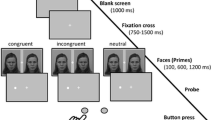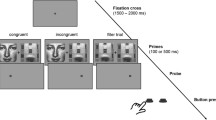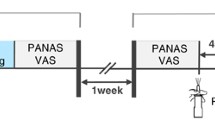Abstract
The current study used double-blind, placebo-controlled design to examine the effect of intranasal oxytocin (OT) on emotion recognition (ER) and visual attention in 60 outpatients presenting for assessment and treatment of emotional disorders. Our primary hypothesis was that OT would improve recognition of happy faces in depressed participants. The main effect of OT on ER accuracy, speed, and proportion of fixations in the eye region was not significant. Diagnostic group (i.e., presence/absence of a depressive disorder) moderated the effect of OT on ER, but not as expected: OT significantly slowed ER speed for all emotions in participants with anxiety disorders, but did not affect performance in participants with depressive disorders. Depressed participants fixated significantly less in the eye region of sad faces than anxious participants. Before OT can be used to target ER biases, additional research is needed to explicate the differential impact of OT on ER speed in patients with anxiety versus mood disorders.




Similar content being viewed by others
References
Armstrong, T., & Olatunji, B. O. (2012). Eye tracking of attention in the affective disorders: A meta-analytic review and synthesis. Clinical Psychology Review, 32, 704–723.
Bartz, J. A., Zaki, J., Bolger, N., & Ochsner, K. N. (2011). Social effects of oxytocin in humans: Context and person matter. Trends in Cognitive Sciences, 15, 301–309.
Bouhuys, A. L., Geerts, E., & Gordijn, M. C. M. (1999). Depressed patients’ perceptions of facial emotions in depressed and remitted states are associated with relapse: A longitudinal study. Journal of Nervous and Mental Disease, 187, 595–602.
Bouhuys, A. L., Geerts, E., & Gordijn, M. C. M. (1999). Gender specific mechanisms associated with outcome of depression: Perception of emotions, coping and interpersonal functioning. Psychiatry Research, 85, 247–261.
Brown, T. A., & Barlow, D. H. (2014). Anxiety and related disorders interview schedule for DSM-5—adult and lifetime version: Clinician manual. New York: Oxford University Press.
Carton, J. S., Kessler, E. A., & Pape, C. L. (1999). Nonverbal decoding skills and relationship well-being in adults. Journal of Nonverbal Behavior, 23, 91–100.
Cohen, J. (1988). Statistical power analysis for the behavioral sciences. Hillside: Erlbaum.
Di Simplicio, M., Massey-Chase, R., Cowen, P. J., & Harmer, C. J. (2009). Oxytocin enhances processing of positive versus negative emotional information in healthy male volunteers. Journal of Psychopharmacology, 23, 241–248.
Domes, G., Normann, C., & Heinrichs, M. (2016). The effect of oxytocin on attention to angry and happy faces in chronic depression. BMC Psychiatry, 16, 92.
Domes, G., Steiner, A., Porges, S. W., & Heinrichs, M. (2013). Oxytocin differentially modulates eye gaze to naturalistic social signals of happiness and anger. Psychoneuroendocrinology, 38, 1198–1202.
Durand, A. C., & Gould, G. M. (1910). A method of determining ocular dominance. Journal of the American Medical Association, 55, 369–370.
Ekman, P., & Friesen, W. V. (1976). Pictures of facial affect. Palo Alto: Consulting Psychologists Press.
Ekman, P., Friesen, W. V., O’Sullivan, M., Chan, A., Diacoyanni-Tarlatzis, I., Heider, K.,.. . Tzavaras, A. (1987). Universals and cultural differences in the judgments of facial expressions of emotion. Journal of Personality and Social Psychology, 53(4), 712–717.
Ellenbogen, M. A., Linnen, A., Cardoso, C., & Joober, R. (2013). Intranasal oxytocin impedes the ability to ignore task-irrelevant facial expressions of sadness in students with depressive symptoms. Psychoneuroendocrinology, 38, 387–398.
Emery, N. J. (2000). The eyes have it: the neuroethology, function and evolution of social gaze. Neuroscience and Biobehavioral Reviews, 24, 581–604.
Fischer-Shofty, M., Shamay-Tsoory, S. G., Harari, H., & Levkovitz, Y. (2010). The effect of intranasal administration of oxytocin on fear recognition. Neuropsychologia, 48, 179–184.
Guastella, A. J., Hickie, I. B., McGuinness, M. M., Otis, M., Woods, E. A., Disinger, H. M., &… Banati, R. B. (2013). Recommendations for the standardization of oxytocin nasal administration and guidelines for its reporting in human research. Psychoneuroendocrinology, 38, 612–625.
Guastella, A. J., & MacLeod, C. (2012). A critical review of the influence of oxytocin nasal spray on social cognition in humans: Evidence and future directions. Hormones And Behavior, 61, 410–418.
Guastella, A. J., Mitchell, P. B., & Dadds, M. R. (2008). Oxytocin increases gaze to the eye region of human faces. Biological Psychiatry, 63, 3–5.
Gur, R. C., Erwin, R. J., Gur, R. E., Zwil, A. S., Heimberg, C., & Kraemer, H. C. (1992). Facial emotion discrimination: II. Behavioral findings in depression. Psychiatry Research, 42, 241–251.
Hale, W. W., III (1998). Judgment of facial expressions and depression persistence. Psychiatry Research, 80, 265–274.
Heinrichs, M., von Dawans, B., & Domes, G. (2009). Oxytocin, vasopressin, and human social behavior. Frontiers in Neuroendocrinology, 30, 548–557.
Hubble, K., Daughters, K., Manstead, A. S. R., Rees, A., Thapar, & van Goozen, S. H. M. (2017). Oxytocin reduces face proecssing time but leaves recognition accuracy and eye-gaze unaffected. Journal of the International Neuropsychological Society, 23, 23–33.
Joormann, J., & Gotlib, I. H. (2006). Is this happiness I see?: Biases in the identification of emotional facial expressions in depression and social phobia. Journal of Abnormal Psychology, 115, 705–714.
Leppanen, J., Ng, K. W., Tchanturia, K., & Treasure, J. (2017). Meta-analysis of the effects of intranasal oxytocin on interpretation and expression of emotions. Neuroscience and Biobehavioral Reviews, 78, 125–144.
Lischke, A., Berger, C., Prehn, K., Heinrichs, M., Herpertz, S. C., & Domes, G. (2012). Intranasal oxytocin enhances emotion recognition from dynamic facial expressions and leaves eye-gaze unaffected. Psychoneuroendocrinology, 37, 475–481.
MacDonald, K., MacDonald, T. M., Brüne, M., Lamb, K., Wilson, M. P., Golshan, S., & Feifel, D. (2013). Oxytocin and psychotherapy: A pilot study of its physiological, behavioral and subjective effects in males with depression. Psychoneuroendocrinology, 38, 2831–2843.
Marsh, A. A., & Blair, R. J. R. (2008). Deficits in facial affect recognition among antisocial populations: A meta-analysis. Neuroscience and Biobehavioral Reviews, 32, 454–465.
Marsh, A. A., Yu, H. H., Pine, D. S., & Blair, R. J. R. (2010). Oxytocin improves specific recognition of positive facial expressions. Psychopharmacology (Berl), 209, 225–232.
McClure, E. B., & Nowicki, S. J. (2001). Associations between social anxiety and nonverbal processing skill in preadolescent boys and girls. Journal of Nonverbal Behavior, 25, 3–19.
McQuaid, R. J., McInnis, O. A., Abizaid, A., & Anisman, H. (2014). Making room for oxytocin in understanding depression. Neuroscience and Behavioral Reviews, 45, 305–322.
Olff, M., Frijling, J. L., Kubzansky, L. D., Bradley, B., Ellenbogen, M. A., Cardoso, C., & … van Zuiden, M. (2013). The role of oxytocin in social bonding, stress regulation and mental health: An update on the moderating effects of context and interindividual differences. Psychoneuroendocrinology, 38, 1883–1894.
Persad, S. M., & Polivy, J. (1993). Differences between depressed and nondepressed individuals in the recognition of and response to facial emotional cues. Journal of Abnormal Psychology, 102, 358–368.
Quintana, D. S., Guastella, A. J., Westlye, L. T., & Andreassen, O. A. (2016). The promise and pitfalls of intranasally administered psychopharmacological agents for the treatment of psychiatric disorders. Molecular Psychiatry, 21, 29–38.
Rilling, J. K., Demarco, A. C., Hackett, P. D., Chen, X., Gautam, P., Stair, S., &. Pagnoni, G. (2014). Sex differences in the neural and behavioral response to intranasal oxytocin and vasopressin during human social interaction. Psychoneuroendocrinology, 39, 237–248.
Schulze, L., Lischke, A., Greif, J., Herpertz, S. C., Heinrichs, M., & Domes, G. (2011). Oxytocin increases recognition of masked emotional faces. Psychoneuroendocrinology, 36, 1378–1382.
Shahrestani, S., Kemp, A. H., & Guastella, A. J. (2013). The impact of a single administration of intranasal oxytocin on the recognition of basic emotions in humans: A meta-analysis. Neuropsychopharmacology, 38, 1929–1936.
Shultz, S., & Dunbar, R. M. (2012). The social brain hypothesis: An evolutionary perspective on the neurobiology of social behaviour. In S. Richmond, G. Rees, S. L. Edwards, S. Richmond, G. Rees & S. L. Edwards (Eds.), I know what you’re thinking: Brain imaging and mental privacy (pp. 13–28). New York: Oxford University Press.
Tollenaar, M. S., Chatzimanoli, M., van der Wee, N. A., & Putman, P. (2013). Enhanced orienting of attention in response to emotional gaze cues after oxytocin administration in healthy young men. Psychoneuroendocrinology, 38, 1797–1802.
Van Ijzendoorn, M. H., & Bakermans-Kranenburg, M. J. (2012). A sniff of trust: Meta-analysis of the effects of intranasal oxytocin administration on face recognition, trust to in-group, and trust to out-group. Psychoneuroendocrinology, 37, 438–443.
Walum, H., Waldman, I. D., & Young, L. J. (2016). Statistical and methodological considerations for the interpretation of intranasal oxytocin studies. Biological Psychiatry, 79, 251–257.
Yoon, K. L., Joormann, J., & Gotlib, I. H. (2009). Judging the intensity of facial expressions of emotion: Depression-related biases in the processing of positive affect. Journal of Abnormal Psychology, 118, 223–228.
Acknowledgements
The authors thank Alice Cronin-Golomb and Kristin Long for their assistance with this study. This research was supported by Grant MH039096 awarded by the National Institute of Mental Health (Brown) and the Boston University Clara Mayo Fellowship (Rutter).
Funding
This study was funded by the National Institute of Mental Health Grant MH039096.
Author information
Authors and Affiliations
Corresponding author
Ethics declarations
Conflict of Interest
Lauren A. Rutter, Daniel J. Norton, Bonnie S. Brown and Timothy A. Brown declare that they have no conflict of interest.
Human and Animal Rights
All procedures performed in studies involving human participants were in accordance with the ethical standards of the institutional and/or national research committee and with the 1964 Helsinki declaration and its later amendments or comparable ethical standards.
Informed Consent
Informed consent was obtained from all individual participants included in the study.
Rights and permissions
About this article
Cite this article
Rutter, L.A., Norton, D.J., Brown, B.S. et al. A Double-Blind Placebo Controlled Study of Intranasal Oxytocin’s Effect on Emotion Recognition and Visual Attention in Outpatients with Emotional Disorders. Cogn Ther Res 43, 523–534 (2019). https://doi.org/10.1007/s10608-018-9974-x
Published:
Issue Date:
DOI: https://doi.org/10.1007/s10608-018-9974-x




